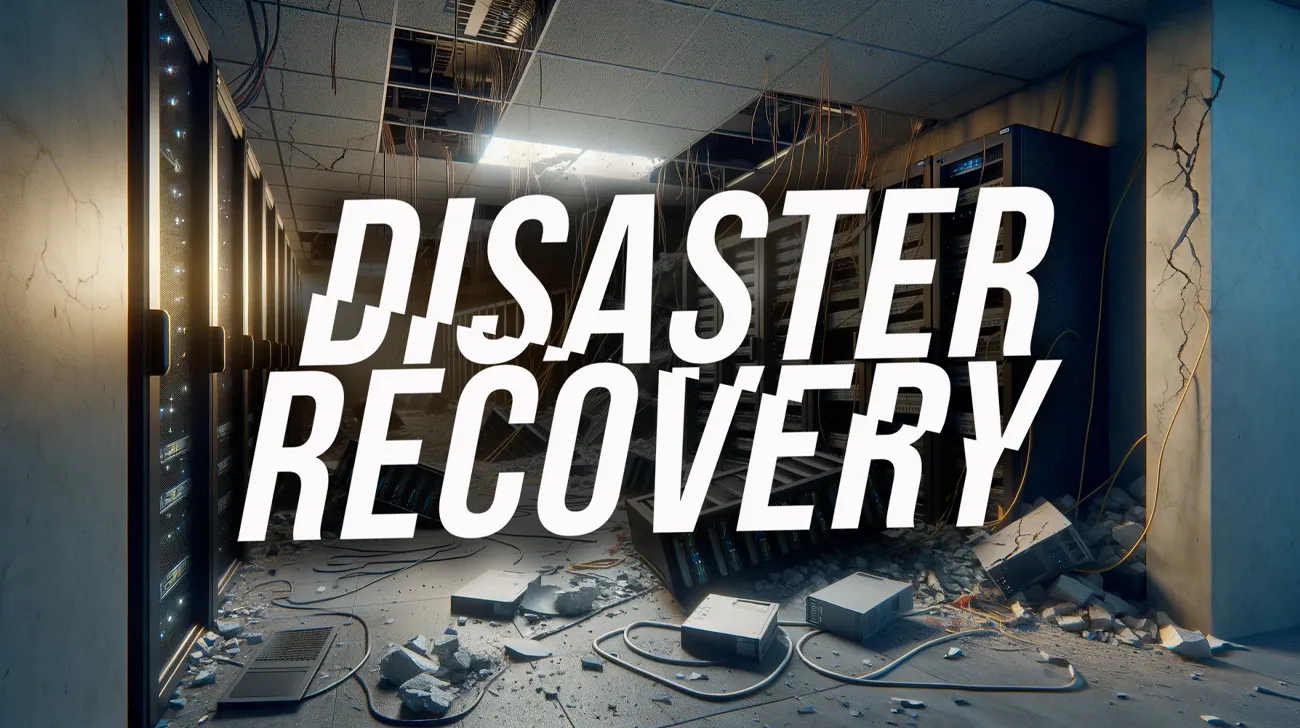Τι είναι το disaster recovery; Στον ταχέως εξελισσόμενο κόσμο της πληροφορικής, όπου τα δεδομένα αποτελούν το αίμα των επιχειρήσεων, ο όρος "disaster recovery" έχει τεράστια σημασία.
Αναφέρεται στις στρατηγικές διεργασίες και διαδικασίες που εφαρμόζουν οι οργανισμοί για τη διασφάλιση των κρίσιμων δεδομένων τους. Επίσης, τα συστήματα ΙΤ μπορούν να ανακτηθούν και να αποκατασταθούν γρήγορα σε περίπτωση καταστροφής ή συμβάντος διακοπής.
Αυτές οι καταστροφές μπορεί να κυμαίνονται από φυσικές καταστροφές όπως τυφώνες και σεισμούς έως cyberattacks, βλάβες υλικού και ανθρώπινα λάθη.
Σε αυτόν τον αναλυτικό οδηγό, θα εμβαθύνουμε στον κόσμο του disaster recovery (DR), εξερευνώντας την έννοια και τον ορισμό του.
Θα εξετάσουμε επίσης τη σημασία του σχεδιασμού disaster recovery, τη σημασία των δοκιμών, τη διάκριση μεταξύ του Recovery Point Objective (RPO) και του Recovery Time Objective (RTO), καθώς και τα πρακτικά βήματα για την εφαρμογή ενός ισχυρού σχεδίου disaster recovery.
Επιπλέον, θα μοιραστούμε ένα πραγματικό παράδειγμα disaster recovery κατά τη διάρκεια του τυφώνα Laura, τονίζοντας τον κρίσιμο ρόλο που έπαιξε το καινοτόμο προϊόν μας.
Disaster Recovery Plan: Σημασία & Ορισμός
Στον πυρήνα του, ένα Disaster Recovery Plan (DRP) είναι ένα τεκμηριωμένο σύνολο διαδικασιών και πρωτοκόλλων που έχουν σχεδιαστεί για την ελαχιστοποίηση της απώλειας δεδομένων, καθώς και του downtime και της διακοπής των υπηρεσιών. Επίσης, εγγυάται την επιχειρηματική δραστηριότητα κατά τη διάρκεια και μετά από μια καταστροφή ή ένα απροσδόκητο γεγονός.
Ένα καλά σχεδιασμένο DRP δεν περιλαμβάνει μόνο τα συστήματα και τα δεδομένα IT, αλλά περιγράφει επίσης τις αρμοδιότητες του βασικού προσωπικού, τις στρατηγικές επικοινωνίας και την κατανομή των πόρων για να διασφαλίσει μια γρήγορη και αποτελεσματική διαδικασία ανάκαμψης.
Ο πρωταρχικός στόχος ενός DRP είναι να επιτρέψει σε έναν οργανισμό να συνεχίσει τις κρίσιμες λειτουργίες του όσο το δυνατόν πιο απρόσκοπτα εν όψει της αντιξοότητας.
Στόχος του είναι να προστατεύσει τη φήμη ενός οργανισμού, την εμπιστοσύνη των πελατών και την οικονομική σταθερότητα, διασφαλίζοντας ότι τα κρίσιμα δεδομένα και υπηρεσίες παραμένουν προσβάσιμα, ακόμη και στο χειρότερο σενάριο.
Ως εκ τούτου, η εφαρμογή λύσεων όπως το σύστημα διαχείρισης καλωδίων PATCHBOX μπορεί να είναι ζωτικής σημασίας για τις εταιρείες και τα data centers ώστε να επανέλθουν σε λειτουργία το συντομότερο δυνατό.
Παράδειγμα Disaster Recovery σε PDF: Το PATCHBOX & ο τυφώνας Laura
Τον Αύγουστο του 2020, ο τυφώνας Laura έπληξε τις ακτές του Κόλπου των ΗΠΑ, αφήνοντας πίσω του ένα δρόμο καταστροφής. Κατά τη διάρκεια αυτού του καταστροφικού γεγονότος, το PATCHBOX διαδραμάτισε καθοριστικό ρόλο στις προσπάθειες αποκατάστασης της καταστροφής.
Ένας από τους πελάτες της, η TRG Datacenters, ανέλαβε τη μετεγκατάσταση server από το data center στο Lake Charles στο data center του Χιούστον. Με τον τρόπο αυτό εξασφαλίστηκε η συνέχιση της λειτουργίας πολλών μικρών επιχειρήσεων.
Σε διάστημα μόλις 36 ωρών, η TRG Datacenters, με τη βοήθεια του καινοτόμου PATCHBOX, επανέφερε online επιτυχώς 27 μικρές επιχειρήσεις, επιτρέποντας σε χιλιάδες εργαζόμενους να συνεχίσουν την εργασία τους.
Η απρόσκοπτη εκτέλεση αυτού του disaster recovery plan κατέστη δυνατή χάρη στο PATCHBOX, το οποίο εξάλειψε την ανάγκη για πολύπλοκο σχεδιασμό καλωδίωσης, εξοικονομώντας πολύτιμο χρόνο και προσπάθεια.
Αυτό το πραγματικό παράδειγμα υπογραμμίζει την κρίσιμη σημασία του σχεδιασμού disaster recovery και τον αντίκτυπο που μπορεί να έχει στην ικανότητα των επιχειρήσεων να ανακάμπτουν γρήγορα από καταστροφικά γεγονότα.
Διαβάστε ολόκληρη την ιστορία στο Παράδειγμα σε PDF. Κάντε κλικ εδώ για να το κατεβάσετε δωρεάν.

Ποια είναι η διαφορά μεταξύ RPO και RTO; Έννοια & Ορισμός
Το Recovery Point Objective (RPO) και το Recovery Time Objective (RTO) είναι δύο κρίσιμες μετρήσεις στο σχεδιασμό disaster recovery.
Recovery Point Objective (RPO): To RPO ορίζει τη μέγιστη αποδεκτή απώλεια δεδομένων που μπορεί να ανεχθεί ένας οργανισμός. Σηματοδοτεί το χρονικό σημείο στο οποίο πρέπει να αποκατασταθούν τα δεδομένα μετά από μια καταστροφή.
Για παράδειγμα, ένας οργανισμός με RPO μίας ώρας δεν μπορεί να χάσει δεδομένα αξίας μεγαλύτερης της μίας ώρας. Το RPO είναι στενά συνδεδεμένο με τις στρατηγικές αντιγραφής και δημιουργίας αντιγράφων ασφαλείας δεδομένων.
Recovery Time Objective (RTO): To RTO αντιπροσωπεύει τον μέγιστο επιτρεπόμενο χρόνο downtime για τα κρίσιμα συστήματα και τις υπηρεσίες ενός οργανισμού.
Καθορίζει πόσο γρήγορα πρέπει να επανέλθουν τα συστήματα ΙΤ μετά από μια καταστροφή. Η επίτευξη χαμηλού RTO απαιτεί αποτελεσματικές λύσεις δημιουργίας αντιγράφων ασφαλείας, εφεδρικά συστήματα και διαδικασίες ταχείας ανάκτησης.
Η εξισορρόπηση των RPO και RTO είναι μια κρίσιμη πτυχή του σχεδιασμού DR, καθώς καθορίζει το κόστος της λύσης αποκατάστασης και το επίπεδο προστασίας που προσφέρει.
Πώς υπολογίζετε τα RTO και RPO;
Ο υπολογισμός των RPO και RTO περιλαμβάνει την αξιολόγηση των ειδικών αναγκών του οργανισμού σας και την εξέταση των πιθανών επιπτώσεων της απώλειας δεδομένων και του χρόνου downtime. Στόχος είναι η ευθυγράμμιση αυτών των στόχων με τους διαθέσιμους πόρους και τεχνολογίες.
Ο τύπος για τον υπολογισμό των RPO και RTO ποικίλλει ανάλογα με την πολυπλοκότητα του περιβάλλοντος ΙΤ σας και την κρισιμότητα των συστημάτων σας.
Για το RPO, πρέπει να καθορίσετε πόσο συχνά γίνεται η δημιουργία αντιγράφων ασφαλείας και η αντιγραφή δεδομένων, λαμβάνοντας υπόψη τον όγκο δεδομένων και το διαθέσιμο bandwidth.
Οι υπολογισμοί RTO απαιτούν την αξιολόγηση του χρόνου που απαιτείται για την επαναφορά μεμονωμένων συστημάτων ή υπηρεσιών. Για να γίνει αυτό, πρέπει να ληφθούν υπόψη παράγοντες όπως το εφεδρικό υλικό και οι δυνατότητες ανάκτησης δεδομένων.
Οι πιο σημαντικές μετρήσεις
Οι ακόλουθες μετρήσεις και στατιστικά στοιχεία διαδραματίζουν καθοριστικό ρόλο στην αξιολόγηση της αποτελεσματικότητας και της ετοιμότητας του σχεδίου disaster recovery ενός οργανισμού.
Μεταξύ των αμέτρητων διαθέσιμων μετρήσεων και στατιστικών στοιχείων, αρκετές από αυτές ξεχωρίζουν ως οι πιο κρίσιμες για να διασφαλιστεί ότι μια στρατηγική DR μπορεί να παρέχει την απαραίτητη προστασία και ανθεκτικότητα.
Πρώτα απ' όλα, το Recovery Time Objective (RTO) είναι μια ακρογωνιαία μέτρηση. Καθορίζει τον μέγιστο αποδεκτό χρόνο downtime για κρίσιμα συστήματα και υπηρεσίες κατά τη διάρκεια μιας καταστροφής.
Τα downtime είναι δαπανηρά και μπορούν να οδηγήσουν σε μακροχρόνιες ζημιές σε μια εταιρεία. Καθώς πρόκειται για ένα πολύ σημαντικό θέμα, σας προτείνουμε το Whitepaper μας σχετικά με τις συνέπειες της κακής διαχείρισης καλωδίων. Μπορείτε να το κατεβάσετε δωρεάν εδώ.
Η επίτευξη των στόχων RTO είναι υψίστης σημασίας, καθώς επηρεάζει άμεσα την ικανότητα ενός οργανισμού να διατηρεί τις λειτουργίες του και να ελαχιστοποιεί τις διακοπές.
Εξίσου ζωτικής σημασίας είναι το Recovery Point Objective (RPO), το οποίο υπαγορεύει την επιτρεπόμενη απώλεια δεδομένων σε περίπτωση καταστροφής.
Το RPO μετράει πόσο συχνά γίνεται η δημιουργία αντιγράφων ασφαλείας και η αντιγραφή δεδομένων, ευθυγραμμίζοντάς τα με τις επιχειρηματικές ανάγκες και διασφαλίζοντας ότι δεν χάνονται πολύτιμες πληροφορίες κατά τη διάρκεια των προσπαθειών ανάκτησης.
Οι μετρήσεις του χρόνου downtime είναι επίσης εξαιρετικά σημαντικές. Αυτά τα στατιστικά στοιχεία παρακολουθούν τη διάρκεια και τη συχνότητα της μη διαθεσιμότητας του συστήματος. Αυτό προσφέρει μια σαφή εικόνα του αντίκτυπου των καταστροφών στην παραγωγικότητα και τα έσοδα.
Η κατανόηση των οικονομικών συνεπειών του χρόνου downtime μπορεί να αναδείξει τη σημασία ενός ισχυρού σχεδίου disaster recovery.
Το ποσοστό επιτυχίας των προσπαθειών ανάκτησης είναι μια άλλη βασική μέτρηση. Αποκαλύπτει το ποσοστό των επιτυχημένων ανακτήσεων σε σύγκριση με το σύνολο των προσπαθειών. Το ποσοστό επιτυχίας ρίχνει φως στην αποτελεσματικότητα της εκτέλεσης του σχεδίου.
Τέλος, το κόστος του downtime δεν μπορεί να υποτιμηθεί. Αυτή η μέτρηση ποσοτικοποιεί τις οικονομικές συνέπειες των διακοπτόμενων λειτουργιών, συμπεριλαμβανομένων των χαμένων εσόδων, της δυσαρέσκειας των πελατών και των δαπανών αποκατάστασης.
Παρέχει ένα πειστικό επιχείρημα για την επένδυση σε ολοκληρωμένες λύσεις ανάκαμψης από καταστροφές.
Συλλογικά, αυτές οι μετρήσεις και τα στατιστικά στοιχεία δίνουν τη δυνατότητα στους οργανισμούς να αξιολογούν την ετοιμότητά τους στην DR, να εντοπίζουν τις αδυναμίες και να λαμβάνουν τεκμηριωμένες αποφάσεις για την ενίσχυση της ανθεκτικότητάς τους.
Παρακολουθώντας και αναλύοντας αυτούς τους κρίσιμους δείκτες, οι επιχειρήσεις μπορούν να δώσουν προτεραιότητα στο disaster recovery, να ελαχιστοποιήσουν τους κινδύνους και να διασφαλίσουν ότι είναι καλά εξοπλισμένες για να αντιμετωπίσουν οποιαδήποτε “καταιγίδα” ή διαταραχή.
Πώς να εφαρμόσετε ένα σχέδιο disaster recovery
Η εφαρμογή ενός ισχυρού σχεδίου disaster recovery απαιτεί συστηματική προσέγγιση. Ακολουθούν τα βασικά σημεία που πρέπει να ληφθούν υπόψη:
Αξιολόγηση και ανάλυση κινδύνου: Ξεκινήστε με τον εντοπισμό πιθανών κινδύνων και την αξιολόγηση των επιπτώσεών τους στον οργανισμό σας. Αυτό περιλαμβάνει την αξιολόγηση της πιθανότητας διαφόρων σεναρίων καταστροφής και την κατανόηση των συνεπειών τους.
Καθορισμός στόχων και προτεραιοτήτων: Καθορίστε σαφείς στόχους RPO και RTO με βάση την αξιολόγηση των κινδύνων σας. Καθορίστε ποια συστήματα και δεδομένα είναι mission-critical και δώστε προτεραιότητα στην αποκατάστασή τους.
Τεχνολογία και υποδομές: Επενδύστε στην απαραίτητη τεχνολογία και υποδομή για την υποστήριξη του σχεδίου disaster recovery. Αυτό μπορεί να περιλαμβάνει λύσεις δημιουργίας αντιγράφων ασφαλείας δεδομένων, εφεδρικό υλικό, εξωτερικά data centers και καινοτόμα προϊόντα ΙΤ, όπως το PATCHBOX Cable Management.
Τεκμηρίωση του DRP: Δημιουργήστε ένα ολοκληρωμένο σχέδιο disaster recovery που περιγράφει όλες τις διαδικασίες, τις αρμοδιότητες και τα πρωτόκολλα επικοινωνίας. Βεβαιωθείτε ότι όλο το βασικό προσωπικό είναι εκπαιδευμένο και εξοικειωμένο με το σχέδιο.
Δοκιμές και εκπαίδευση: Δοκιμάζετε τακτικά το DRP σας μέσω προσομοιώσεων και ασκήσεων. Χρησιμοποιήστε αυτές τις δοκιμές για να εντοπίσετε τις αδυναμίες και να κάνετε τις απαραίτητες προσαρμογές. Εκπαιδεύστε τους υπαλλήλους σχετικά με τους ρόλους τους κατά τη διάρκεια μιας καταστροφής.
Τακτικές ενημερώσεις και συντήρηση: Ενημερώνετε συνεχώς το σχέδιο disaster recovery, ώστε να λαμβάνονται υπόψη οι αλλαγές στην τεχνολογία, την υποδομή και τις επιχειρηματικές διαδικασίες. Διασφαλίστε ότι παραμένει σχετικό και αποτελεσματικό.
Επικοινωνία και Αναφορές: Καθιέρωση σαφών διαύλων επικοινωνίας για την ειδοποίηση των εργαζομένων, των εμπλεκομένων μερών και των πελατών κατά τη διάρκεια μιας καταστροφής. Αναπτύξτε ένα σύστημα υποβολής αναφορών για να ενημερώνονται όλοι για την πρόοδο της επαναφοράς.
Παρακολούθηση και συμμόρφωση: Εφαρμόστε εργαλεία παρακολούθησης για να ελέγχετε την κατάσταση των συστημάτων και των δεδομένων ΙΤ σας. Βεβαιωθείτε ότι το σχέδιο disaster recovery συμμορφώνεται με τους σχετικούς κανονισμούς και τα πρότυπα του κλάδου.
Δοκιμές disaster recovery
Ο αποτελεσματικός σχεδιασμός disaster recovery είναι ελλιπής χωρίς αυστηρές δοκιμές. Η τακτική δοκιμή του DRP είναι απαραίτητη για τον εντοπισμό πιθανών αδυναμιών. Επιτρέπει την αξιολόγηση της εφαρμοσιμότητας των στόχων ανάκαμψης και την εκπαίδευση του προσωπικού που εμπλέκεται στην εκτέλεση του σχεδίου.
Η δοκιμή επιτρέπει στους οργανισμούς να βελτιώσουν τις στρατηγικές τους, διασφαλίζοντας ότι σε μια πραγματική καταστροφή, το σχέδιο θα λειτουργήσει όπως προβλέπεται.
Οι συνήθεις μέθοδοι δοκιμών disaster recovery περιλαμβάνουν ασκήσεις στο τραπέζι, μερικές δυσλειτουργίες και προσομοιώσεις πλήρους κλίμακας. Κάθε προσέγγιση εξυπηρετεί έναν συγκεκριμένο σκοπό, βοηθώντας τους οργανισμούς να αξιολογήσουν την ετοιμότητά τους και να βελτιώσουν τις διαδικασίες τους.
Συμπέρασμα
Στη σημερινή ψηφιακή εποχή, το DR δεν είναι απλώς μια επιλογή αλλά μια αναγκαιότητα για τις επιχειρήσεις όλων των μεγεθών.
Η κατανόηση της έννοιας και της σημασίας του σχεδιασμού, των δοκιμών και της υλοποίησης του disaster recovery είναι ζωτικής σημασίας για τη διασφάλιση των δεδομένων, της φήμης και της συνέχειας του οργανισμού σας μπροστά σε απρόβλεπτες προκλήσεις.
Ακολουθώντας τις βέλτιστες πρακτικές και παραμένοντας σε εγρήγορση, μπορείτε να διασφαλίσετε ότι το σχέδιο disaster recovery είναι έτοιμο να αντιμετωπίσει κάθε αντιξοότητα που θα σας βρει.













